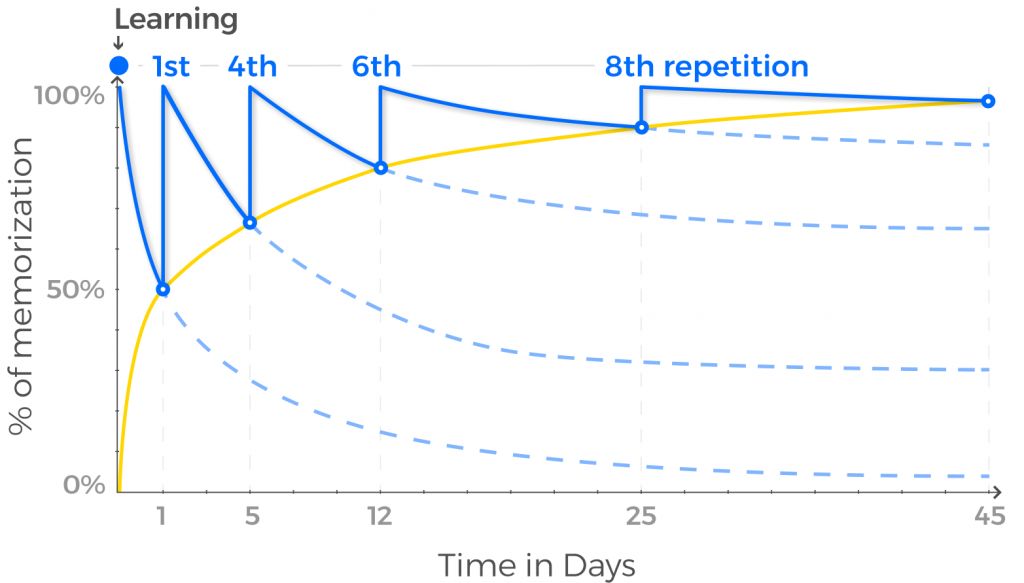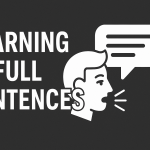A major key to learning a foreign language is memorizing vocabulary. Without a doubt, this is a challenging task. But the good news is we all possess a degree of control over how many words in a foreign language we can memorize and use.
No matter the language you’re learning or methods you choose, you’ll need to memorize thousands of vocabulary words. Not only that, but you need to develop the ability to recall these foreign words on-demand and combine them to create coherent, conversation worthy sentences.
- How your brain memorizes vocabulary in another language
- The role of short-term memory in memorizing new vocabulary
- Optimizing for long-term memory is key to learning another language
- Memorizing sentences means memorizing words
- Best ways to memorize vocabulary in a foreign language
- Mnemonics and visualization
- How listening helps memorizing new words
- In Closing
At Taalhammer, we’re obsessed with helping our students get the most out of their language learning journey. In this article, we’re going to delve deep into the fundamentals of what is the best way to memorize words in a foreign language. We’ll uncover how your brain best learns languages, help you maximize your memory efficiency and vocabulary memorization and equip you with the best techniques to acquire your desired language faster.
How your brain memorizes vocabulary in another language
Your brain is the product of millions of years of evolution. This great feat of engineering is a marvel capable of storing the equivalent memory capacity of 2.5 million gigabytes (that’s an astounding 125,000,000,000,000 words — an essentially infinite number).
Our brains are a by-product of our early development. This early development geared our brains toward remembering where food was located. Our ancestors’ ability to remember where they’d found food enabled them to retrieve more later. This ability to retrieve more food later was vital to our survival.
Our extraordinary capacity for storing memories was built on our ancestors’ desire to survive, not for memorizing words. Therefore, we need to find the best techniques to work with the way our brains memorize. This way, we can bolster our capacity to memorize vocabulary words and language in general.
While our brains are capable of storing vast amounts of memories, this doesn’t mean it’s always efficient. Our brains are just as good at forgetting memories as they are remembering them. This means learning a foreign language requires effective, conscious methods.
We need to be able to learn in a way that works in tandem with how our brains are wired. We need methods that help us retain what we learn and negate our brain’s desire to shed information.
The process of storing memories for later access happens in three stages: encoding, storage and retrieval.
Stage 1: Encoding
Encoding occurs through exposure to images, sounds or meaning. In the context of language acquisition, the encoding process needs to be triggered through these forms.
Stage 2: Storage
This stage involves holding information for extended periods of time. It’s made up of short-term memory and long-term memory.
Stage 3: Retrieval
Your ability to retrieve information from memory is vital. Without being able to effectively retrieve what you’ve studied, you can’t use what you’ve learned.
The role of short-term memory in memorizing new vocabulary
Memorizing new vocabulary starts with your short-term memory (also called working-memory). This is the part your brain would use to repeat a sequence of numbers in reverse order, for example.
Everything you learn has to go through short-term memory first. Your brain will then decide whether what you learn will be stored in long-term memory or whether it should be discarded. In other words, you only remember what’s relevant to the brain. Therefore, we need to ensure we learn our foreign language in a way that’s interpreted as relevant to our brain.
Short-term memory is like a funnel through which you pour water. The water, in this case, is the flow of words and sentences you’re trying to learn. Pour slowly and methodically and the whole contents can travel through. Pour too quickly, however, and the funnel chokes and you loose contents.

With regard to studying languages, this looks like trying to cram in too many foreign words at once. You might think you’re doing a lot at the time, but you won’t remember much of the contents. Therefore, you need to optimize your learning capacity.
Optimizing for long-term memory is key to learning another language
To master a language, you need to store enough vocabulary words in your long-term memory. As we’ve already stated, this requires your brain to shuttle the acquired knowledge from your short-term memory to a more permanent one.
It’s important to understand that long-term memory is divided into two parts, explicit and implicit.
Explicit: This is where your knowledge of individual words and grammatical rules are stored.
Implicit: This is the powerful, completely unconscious part where deep linguistic knowledge such as proper sentence structure and complex grammatical aspects like collocations are stored.
On its own, explicit memory is not enough. But your implicit one is a treasure trove of knowledge. To master a language, we need to be able to tap into our implicit memory stores on demand. We see this every time we speak our native tongue. It’s effortless and automatic. We string together words without much effort. This is the result we want to achieve.
Memorizing sentences means memorizing words
To speak another language, we need to know many words. But words by themselves are virtually useless. To become proficient, we need to be able speak real, intelligible sentences.
Memorizing isolated words and then trying to place them in the correct order is tedious and ineffective. On the contrary, learning by heart complete sentences has several distinct advantages.
Your brain is optimized to store data with context. Data with context is more valuable because it provides meaning. Full sentences are examples of how words are used in context and as such are far more useful for real life situations than singular words.
Your brain cuts the data it retrieves into fragments, then identifies patterns like important grammatical rules. In the context of learning a language, this is precisely what your brain did while you were learning your native language. Use a method optimized for this natural process and you’ll speak with accurate grammar without needing to learn the grammatical rules.
While learning sentences in a foreign language right off the bat might seem daunting, the fact is using a language is about speaking sentences, not isolated words. You’ll have fun speaking complete, useful, relevant sentences. With enough practice, they’ll solidify into your memory, and you’ll more quickly master the language you’re learning.
Taalhammer has been designed to employ this superior way. Firstly, we introduce new vocabulary words and then help you exercise their use with sentences relevant to you. Simply type in what you want to learn in the advanced editor and presto, with one click, Taalhammer translates it, adds accurate audio pronunciation, creates flashcards and adds this to your individual learning stream. Then, it helps you retain and learn important variations of these sentences to form questions, negations, conditions and more.
Tip: Speak the sentences you’re learning aloud with each repetition. This’ll help your brain better retain the vocabulary while simultaneously practicing pronunciation.
Best ways to memorize vocabulary in a foreign language
In this paragraph we give the best tips on how to memorize foreign vocabulary and help you learn faster. For best results use a combination of techniques.
Spaced repetition for scientifically-backed language learning
Spaced repetition is used by polyglots and language learners alike wanting to use the best, most scientifically-backed techniques to improve their brain’s memory recall and make the words stick.
Spaced repetition drastically improves your brain’s ability to recall what you study. In this case, your ability to remember the meaning of the words.
Over a century’s worth of research shows we’ll lose what we learn if we don’t need it. And we don’t need what we don’t use. Consequently, if you don’t systematically practice using what you learn, you’ll forget 90% of it within the first month. This phenomenon is referred to as the forgetting curve.
However, we know we can combat this with another phenomenon called the spacing effect.
The spacing effect describes how we can learn more effectively and better retain what we’ve learned when we space out our learning over time. Generally speaking, we’ve found five to seven repetitions are usually enough to permanently remember vocabulary.

Follow this process on a regular basis and you’ll retain your information with 90-95% accuracy. Over the course of a year, that’s more than 10,000 vocabulary words or sentences. Not only is this process more enjoyable and easier to handle, but it yields superior results.
Think of language training as building a brick wall. As a language learner, you want a strong foundation. Stack your bricks too quickly or with too much force and you’ll slather only a thin and superficial veil of mortar between your bricks. Stack your bricks with carefully and evenly spread mortar, however, and you’ll build a solid foundation.
Created by experts, Taalhammer uses a custom spaced repetition algorithm. It’s designed and tuned specifically for memorization of large numbers of foreign sentences. Take advantage in both learning and listening mode for an immersive, tailored experience.
Mnemonics and visualization
Mnemonics and visualization techniques are effective cognitive tools and practices used by the world’s top language learners. Mnemonics techniques are such potent techniques that Anthony Metivier, world-renowned memorization expert, is a staunch proponent of using them.
Mnemonics is a branch of mental techniques that help us organize, retain and remember more. With regard to language acquisition, mnemonics can help you acquire your desired foreign language faster.
One such mnemonic technique is memory palace. This technique requires the creation of an imaginary construct based on a real location. For example, if you can visualize your bedroom, you can build a memory palace. Once you’ve decided where to build your palace, you would then make a mental list of the things you want to memorize. In the context of languages, these will be foreign words and sentences. This could be a grocery list, posters on a wall or your wardrobe. You’ll then link these areas with the words you want to remember. For example, if you’re learning French, you could visualize a poster of a train station above your bedside table titled La gare.
As you can see, mnemonics is largely about visualization and visual associations. The memory palace technique combined visualization with word linking.
It’s not only memory palaces we can create to help us acquire languages more quickly. Rather than visualizing a specific area and building on it, we can link foreign words and phrases with anything we can imagine.
Here’s an example using the French ‘la gare’ once more. We’ll also use learning Polish as part of this example. The French word ‘gare’ sounds like the word ‘gar’, Polish for ‘a very big pan’. By visualizing someone standing in the train station and cooking with a very big pan, you link these words and increase the likelihood of remembering them.
Here’s another example. The word for ‘love’ in Indonesian is ‘cinta’. This sounds similar to the Italian ‘incinta’, which means pregnant. Using this imaginary and sound similarity, we can easily connect ‘love’ to ‘pregnant’ across languages.
Sleep
We all know getting enough quality sleep is vital to our health and wellbeing. But did you know sleep is crucial to getting the most out of your foreign language learning?
If you’ve ever noticed that you remember vocabulary better after a nap or a good night’s sleep, then you aren’t mistaken. It’s because we memorize and therefore learn a lot more with quality sleep hygiene. Biologically, our memories require consolidation. And consolidation happens only when we sleep. It’s through consolidation that we learn new things, like foreign languages.
Sleep reorganizes the networks in our brains. As an analogy, we can compare our brains to a computer. Your brain repeats a write and defragmentation cycle as you sleep. These are your sleep cycles. It’s during these sleep cycles that your brain, piece by piece, sorts and consolidates information.
What does this mean for learning languages? Firstly, it’s during the brain’s sleep functions that it moves words and sentences from short-term memory to long-term memory. Further, it’s during this time your brain redistributes and optimizes your storage for languages. This is when your brain connects seemingly unrelated patterns so it can extrapolate, internalize and solidify grammatical rules.
Good sleep hygiene will maximize the effectiveness of your brain’s ability to organize and store seemingly unstructured data into usable information. Consequently, emphasizing regular, quality sleep results in you learning more effectively.
For maximum language acquisition, we recommend taking a nap straight after your study periods. If you can, follow a sleep-learn-sleep cycle. Repeat this as often as you can. Do this and you’ll retain more of your desired language and learn it much faster.
Tip: Taking a nap immediately after a learning session forces the brain to move the newly acquired language from your short-term to long-term memory.
Physical exercise
Physical exercise does wonders for your health. But did you know it’s also an incredible tool to improve your vocabulary learning?
The best time to learn a language and vocabulary is when your brain is at maximum alertness. We know scientifically that there are two blocks in our day when our brains are at their most alert. The first best block to study is five hours after waking. The second is later in the afternoon, or 9-13 hours into your day.
Interestingly, a number of recent studies have shown exercising around the time of study amplifies our ability to memorize and retain foreign vocabulary. Weightlifting, walking, cycling, anything that forces you to exert physical effort counts.
Exercise enhances your alertness, and can be a fantastic aid to your study sessions. Further, exercise alters the biology of the brain, making it more malleable to learning. Further, the increased oxygen flow to the brain exercise provides and its aid in helping your brain release more neurotransmitters results in better processing and storing of new words.
Best of all, exercise has been shown many times to improve sleep quality. And, as we’ve already discussed, better sleep hygiene means better results.
But don’t go too crazy. Exercise that’s too vigorous can raise your stress levels, which can impede memorization.
Tip: Study your desired language while exercising by listening and repeating for maximum retention and acquisition.
How listening helps memorizing new words
Learning a foreign language and acquiring new vocabulary words requires plenty of attentive listening.
Through listening attentively, we tell our brains what we’re listening to is important. It’s through consciously listening to our new language being spoken that we signal to our brains that the sounds are relevant to our lives.
You need to listen to both the words and phrases you already understand and to content you don’t yet understand. This content should include the vocabulary, as well as sources such as movies, books and podcasts. You can also learn a language with songs.

Not only can it be fun, but listening helps us segment the speech into words and sounds. This helps us get accustomed to the cadence, stresses and rhythm of the new language.
To maximize effectiveness, listen on the go. Studies have repeatedly shown physical movement decreases the amount of time it takes to learn a new language. Listen, move, repeat, and you’ll learn your target language even faster.
A good example of this is the shadowing method. It’s used by polyglots and language experts around the world to learn vocabulary more efficiently.
The shadowing method is a foreign language learning technique in which you repeat audio straight after listening to it. You listen to the words, then immediately repeat them aloud. In essence, you act like its echo — hence the name ‘shadowing technique’.
Tip: Use the shadowing method while walking. Listen as you walk and repeat what you hear aloud.
Taalhammer has been designed to support listening activities. Equipped with AI-powered listening exercises, Taalhammer provides a personalized challenge. With Listening Mode, words and sentences and short stories for shadowing methods. This way, it helps you improve your speech segmentation ability and consolidates your understanding.
We’ll challenge you with a stream of mixed item listening exercises alternating between easy and adequately challenging. This way, you’re properly challenged without being overwhelmed. Our intelligent algorithm keeps you engaged, optimizes the learning curve and allows you to continuously improve.
In Closing
Learning a language is both fun and challenging. For most of us, it takes time and conscious, constant effort. Luckily, understanding how our brains work and using the right tools and techniques can increase our abilities and improve our ability to speak our desired target languages.
Every day, Taalhammer helps language learners around the globe to become more efficient and confident. Designed by expert polyglots, the Taalhammer app equips learners with the most efficient and scientifically-backed studying methods. What’s more, instead of being a tedious chore, Taalhammer makes learning new languages fun and rewarding.
If you are learning Dutch, German or Italian look at our courses descriptions.
References
- https://www.medanta.org/patient-education-blog/what-is-the-memory-capacity-of-a-human-brain/
- https://simplypsychology.org/memory.html
- https://www.fluentin3months.com/memory-palace/
- https://pencilcase.org/study-skills/how-to-study/short-versus-long-term-memory
- https://howtogetfluent.com/shadowing-for-language-learning/
- https://elearningindustry.com/forgetting-curve-combat
- https://www.ncbi.nlm.nih.gov/pmc/articles/PMC3768102/
- https://www.health.harvard.edu/blog/regular-exercise-changes-brain-improve-memory-thinking-skills-201404097110
- https://www.taalhammer.com/the-best-way-to-learn-a-language-is-through-sentences/
- https://health.clevelandclinic.org/how-exercise-affects-your-sleep/
- https://www.berlitz.com/blog/embodied-language-learning







